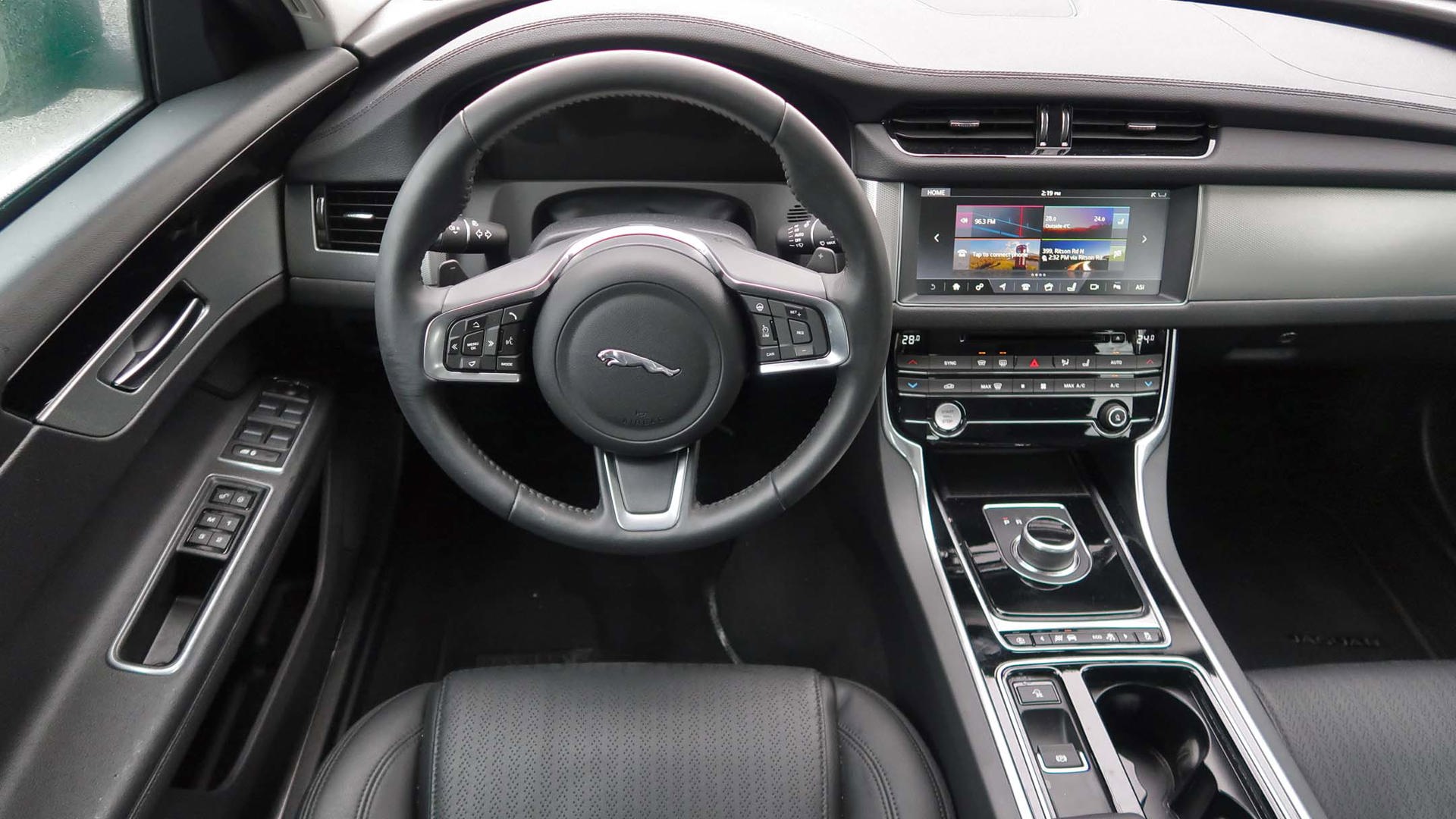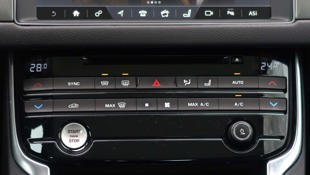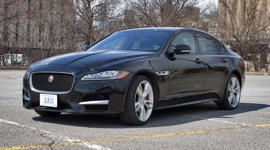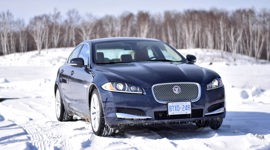 AutoTrader SCORE
AutoTrader SCORE
-
STYLING9/10
-
Safety9/10
-
PRACTICALITY8/10
-
USER-FRIENDLINESS6/10
-
FEATURES8/10
-
POWER6/10
-
COMFORT9/10
-
DRIVING FEEL7/10
-
FUEL ECONOMY8/10
-
VALUE6/10
Automakers are continually offering more choices to meet tightening fuel economy standards. One that’s becoming common is downsized engines – adding small-displacement turbos in place of larger powerplants.
After giving it a quick top-up after getting it, and then listening to it run, I thought, Did I just put gas in a diesel?
While the only gasoline choice last year was a supercharged V6, the 2018 Jaguar XF gets a new 2.0L turbo four-cylinder. Less money and less weight, but unfortunately, colour me less than impressed with it.
The new powerplant is part of Jaguar’s “Ingenium” engine family, featuring all-aluminum construction, lower friction levels, twin-scroll turbochargers, continuously variable valve lift, and automatic stop-start technology, along with “smart” regenerative braking to capture kinetic energy for battery charging, which is now showing up on many non-hybrid engines.
There are actually two versions of this four-cylinder, starting with my tester, the 25t, where it makes 247 hp and starts at $58,900; and the 30t, where it cranks out 296 hp and begins at $61,400.
The field is filled out with the 20d, which uses a 2.0L turbodiesel and slots between the 25t and 30t at $60,900; and the carried-over XF S, with 380 hp supercharged V6, starting at $74,500. All use an eight-speed automatic transmission. While American buyers can opt for two-wheel-drive versions, all XF models in Canada are standard with rear-biased all-wheel drive.
The 25t’s engine does well enough off the line. Its 269 lb-ft of torque hits its mark at just 1,200 rpm, which gives it a nice little kick to get everything going, although it gets a little husky at the higher end of its range.
But it’s also very harsh, to the point that I actually second-guessed myself. After giving it a quick top-up after getting it, and then listening to it run, I thought, Did I just put gas in a diesel? It’s so loud and clattery that I actually double-checked the badge.
It can idle very rough, and the transmission often bumbled when decelerating at slow speeds in traffic, with stuttering that felt like clutch chatter. And no doubt in the interest of fuel economy, the gearbox loves to keep the engine fenced in between about 1,000 and 1,500 rpm, where it’s rough and noisiest. (Yes, it was running a full tank of premium.)
All of that would have been annoying enough in a grocery-getter, but between my car’s mid-level Prestige trim, and a considerable number of checkmarks on the options list, it was $72,700. And it’s a Jaguar. This is not how a Jaguar is supposed to idle, or run, or drive. Now, I haven’t tried the higher-horsepower four-cylinder, nor the diesel, but I drove the V6 last year and was extremely impressed. If this is the future of fuel efficiency, I’d rather shell out the difference and enjoy the drive. (For the record, against the car’s published combined rating of 8.8 L/100 km, I averaged 11.8 in very-cold-weather driving.)
The engine’s too-rough edges are really a shame, because otherwise, the XF is a great driver. Redesigned into its second generation last year, it’s much stiffer than before, and it’s almost perfectly tuned between sports-sedan handling and luxury ride. The power steering doesn’t feel electrically assisted – although it is, of course – but just an organic extension of the steering input, pushing the big cat’s nose into a curve and then guiding it back into the next one. The weight is right, the feedback is right, and the car is almost perfectly balanced front to back.
It’s great-looking as well, with that long nose and unmistakable face, good proportions and just enough chrome. It hunkers down over multi-spoke wheels that fill their wells, and though it’s both aerodynamically and aesthetically low in all the right places, I’ve put a six-foot-plus passenger in the back seat who was fine with both the headroom and legroom.
The cabin is lovely and looks the part of a luxury sedan, with its stitched dash, top-notch materials, and of course the traditional Jaguar touches. The starter button flashes red in the pattern of an actual Jaguar’s heartbeat. The dial gearshift sits flush in the console until the engine starts, whereupon it rises up for work. (Yes, there are a few online horror stories of what’s required if it doesn’t…) The two outer climate vents also open and close automatically with the ignition. And should you need your reading lights at night, don’t bother with a button; simply brush your finger lightly over the lens.
The seats are supportive, but they don’t have much height adjustment. That’s fine for taller drivers – sit low-and-sporty, I know – but I have a bit of a verticality challenge, and visibility suffered on my shoulder checks. Speaking of looking, Jaguar offers a heated front windshield to improve your outward vision on frosty mornings, but you might want to test drive a vehicle with it before you plunk down your $410 for it. It uses tightly spaced heating wires embedded vertically in the glass, and once you notice they’re there, they are all you see. I have to work hard to look past them, and it gets tiring on a long drive.
And then there’s Jaguar’s infotainment and control interface. Let’s just say I’m not a member of the fan club. It’s needlessly overwrought, requiring far too many actions (and resulting distractions) for functions that should be drop-dead simple. Take my heated and ventilated seats. Hit a hard button on the console, or the screen icon. Wait for the screen to come up. Tap the icon for the appropriate seat. Now tap a tiny arrow at just the right spot to adjust the temperature. At 100 km/h. Yeah.
That’s way too much as it is, but down on the centre console, conveniently placed right below the shifter dial, is a long plastic bar for the driving mode selection. How about putting some hard buttons for the seats there, and moving the driving modes – which you probably change far less frequently – in the screen? It’s not like there isn’t room: the bar itself just takes up space, because the modes themselves are controlled by two small buttons at either end of it. (Although, to its credit, the car remembers your last selection, and doesn’t default to Normal the next time the engine starts if you last chose Dynamic.)
I know this is far from unique to Jaguar, but enough is enough. Premium automakers seem to think that buyers are furiously cross-shopping for the most convoluted controller systems on the market. For the stuff we use regularly – climate, volume, seats – simple is good. And safe. Really. Trust me on this.
I still haven’t changed my high opinion of the V6-powered XF, and I want to see if the other two four-cylinder engines are any better. But when it comes to this entry-level engine, I’m disappointed. It’s peppy off the line and it gets you where you’re going, but any car can do that. If I’m spending Jaguar money on my ride, I want that cat on the grille to growl on the go, and purr on the slow. I’m just not seeing enough well-rounded performance on this model to justify the spend.
| Engine Displacement | 2.0L |
|---|---|
| Engine Cylinders | I4 |
| Peak Horsepower | 247 hp @ 5,500 rpm |
| Peak Torque | 269 lb-ft @ 1,200 rpm |
| Fuel Economy | 10.1/7.2/8.8 L/100 km city/hwy/cmb |
| Cargo Space | 505 L |
| Model Tested | 2018 Jaguar XF 25t AWD Prestige |
| Base Price | $63,700 |
| A/C Tax | $100 |
| Destination Fee | $1,500 |
| Price as Tested | $74,300 |
|
Optional Equipment
$9,000 – Heated windshield $410; Comfort and Convenience Pack (hands-free trunk, heated and cooled front seats, heated rear seats) $2,200; Technology Pack (Connected Service pack, 10-inch central screen, navigation, TFT virtual instrument cluster, voice control) $3,170; Vision Assist Pack (forward camera, adaptive headlamps, emergency braking, blind spot monitoring, lane departure warning) $2,550; Santorini Black paint $670
|
|











































